
Housing SLC
6/13/23: After a public hearing on June 6, 2023, the City Council voted to adopt Housing SLC as the City’s new five-year housing plan on June 13, 2023.
The Plan
Housing SLC is a plan to guide the City’s housing-related efforts over the next 5 years. This plan is based on what we learned from over 6,500 residents when we asked them about their needs and their vision for Salt Lake City. Six key findings came out of these interactions, which are listed below.
Key Findings
- Rental vacancy rates are low and home sale prices are unaffordable to most residents, putting strain on existing rental housing and causing rents to rise dramatically.
- Despite a housing construction boom, housing prices suggest a shortage of housing supply overall, but especially housing that is deeply affordable (affordable to renters earning 30% of AMI or less), with demand for housing outpacing supply.
- Salt Lake City is majority renter, and nearly half of all renters are cost burdened, spending more than 30 percent of their income on housing costs. Residents are concerned about renter’s rights and resources.
- According to a survey of city residents, affordable housing and behavioral health services are preferred over additional emergency shelters and homeless resource centers as solutions for homelessness.
- There is a mismatch between the types of housing the market is producing and the needs of the community. Residents perceive that most new housing is “luxury” while many desire more affordability throughout the city. Additionally, residents want more “missing middle” housing and more family-sized housing.
- Wages have not kept pace with cost of living, especially housing-related costs, and residents are feeling increased stress about everyday expenses.
To address these key findings, the City developed the following three goals and associated metrics to measure progress. These goals are supported by more than 40 action items that will be implemented over the next five years.
As progress is made, updates will be posted to this page so that you can monitor progress.
Read the Plan without appendices (small file size)
Read the plan with all appendices (large file size)
Goals & Metrics
1. Make progress toward closing the housing gap of 5,500 units of deeply affordable housing and increase the supply of housing at all levels of affordability.
- Entitle 10,000 new housing units throughout the city.
- Minimum 2,000 units deeply affordable (30% AMI or below)
- Minimum 2,000 units affordable (31% – 80% AMI)
2. Increase housing stability throughout the city.
- Track, analyze, and monitor factors that impact housing stability in the City.
- Assist 10,000 low-income individuals annually through programs funded to increase housing stability by the City.
- Dedicate targeted funding to:
- mitigate displacement;
- serve renter households;
- serve family households;
- increase geographic equity; and
- increase physical accessibility.
3. Increase opportunities for homeownership and other wealth and equity building opportunities.
- Provide affordable homeownership and wealth and equity building opportunities to a minimum of 1,000 low-income households.
Housing SLC sets goals and a plan of action for making housing in Salt Lake City more available and attainable to people of all incomes. Housing SLC lays out policies, land use practices, resources, and funding that can help housing in our communities be more affordable, more accessible, and better reflective of our needs. What is a housing plan? A housing plan is more than a vision. It is a plan of action for making housing safer, more affordable, and more available to everyone. It is an opportunity to set goals and make plans to reach those goals. The State of Utah requires that cities have a housing plan that meets certain requirements. Housing SLC will meet those requirements, but it will do so much more. It will help guide the City’s efforts for the next five years, and it will encourage ways that the community can be involved in making Salt Lake City a place where we all can thrive. Why does a housing plan matter? We all need housing. And we all need housing that meets our needs. Over the past few years, Salt Lake City has become less affordable, and far too many people are spending far too much of their income on having a place to sleep at night. Far too many people can’t find housing. New housing is being built at a record pace, but people are still being priced out and displaced. Without a plan to set a vision, goals, and a plan of action, we can’t hope for change. And the City can’t do it on its own. We need help from residents, non-profits, other governments, and community organizations. Background Information
What is a housing plan? A housing plan is sets goals and priorities to help make living in Salt Lake City safer, more affordable, and more comfortable for everyone. Too many people spend too much of their income on housing, and without a plan, nothing will change. A housing plan will guide City efforts on policies, programs, and funding opportunities to make it easier and more affordable to live. What did the last SLC Housing Plan accomplish? How does it relate to this new Housing Plan? Growing SLC accomplished or made significant progress toward accomplishing 27 of 27 goals. You can check out a progress update from December 2021 here. While Growing SLC saw success, the dramatic increases in housing costs were unforeseen, taking everyone by surprise. In addition, the COVID-19 pandemic had dramatic impacts on the cost to build housing. Why do we need a housing plan? Everyone needs housing. And everyone needs safe, comfortable, and adequate housing that they can afford. If we don’t have a housing plan, we are saying that we trust that the market will solve the problem for us. We have seen enough to know that the market will not solve the housing crisis. Rents and for-sale housing costs have increased rapidly and much faster than wages. Putting together a plan of action to intervene and help make housing more affordable for everyone, but especially individuals and families with low incomes, is not only the right thing to do, but it is essential for a functioning society. What does the RDA do and how do they fit into the housing plan? The RDA’s mission is “Strengthening neighborhoods and business districts to improve livability, create economic opportunity, and foster authentic, equitable communities.” They develop and manage project areas that gather funding that can help areas grow. Through these project areas, they collect funding that is dedicated to creating affordable housing. The RDA’s Board of Director’s has established the need for deeply affordable (30% AMI) housing and the need for family housing as priorities for the RDA. You can find out more here. How does zoning impact affordable housing? Zoning determines what can be built where. Some areas of the city are zoned for single family homes, others are zoned for industrial uses. Still others allow a mix of uses. Because zoning sets the rules for what can go where, it matters a lot to housing. In a built-out city like Salt Lake City, changing zoning to allow for more density – and more housing – in more places helps us build more housing, which can help lower the costs of housing. There are also zoning tools that also allow the City to encourage affordable housing in different areas. Zoning changes are passed by the City Council. Where can I find affordable housing? You can visit the Utah Affordable Housing Database to find affordable housing throughout the state. You can also visit the Housing Stability division’s website for more resources. For immediate assistance, you can call the Housing Authority of Salt Lake City at 801-487-2161. Why is housing so expensive? There are a number of reasons why housing is so expensive. • After the Great Recession, housing development slowed down a lot. Population growth, however, did not slow. This created a mismatch between supply and demand. There are far more people needing a place to live than there are places to live. A report by the Kem C. Gardner Policy institute estimates that Utah is facing a shortage of over 44,000 housing units. This means that there is just not enough housing for people. • Because there are not enough units, landlords can continue to raise rents, knowing that people will pay because people need places to live. • The State of Utah does not allow cities to implement rent control policies. This means that the City can’t put a cap on how much rent can be increased each year. • Wages have also stagnated. Since the 1970s, wages have stayed pretty much the same when adjusted for inflation. So even though the rents have increased a lot, wages have not kept pace. The minimum wage hasn’t been increased since 2009. • In the 1970s, the Federal government stopped building public housing projects and shifted to more market-based solutions to housing people. This means that housing costs are up to landlords and developers. Re-investing in publicly owned housing or creating opportunities for community-owned housing can help keep rents more affordable. Why is there so much new housing development going up, but new affordable housing is still limited? • Building housing is expensive and developers and investors need to not only pay off loans but also have returns on investment. To do that, they need to have rents that cover their costs and bring in the return on investment. To build affordable housing this way, public dollars need to be invested to subsidize the units so that the lower rents can allow for loans to be repaid and returns on investment to be met. The more affordable the rent, the more subsidy has to be committed to make it work financially. • The cost to build housing has increased over the past two years as supply chains have made materials more expensive and as there is a shortage of construction labor. These are hard barriers to overcome for a private developer. It is easier, and a safer investment, to build for market rate renters, which means that affordable housing may not be built at the rate it is needed. • The market will never build deeply affordable housing (affordable to people making 30% of the area median income). Housing is too expensive to build and deeply affordable rents too low that a project will not make economic sense. Governments and non-profit developers need to fill this market gap. What tools can the City use to make housing more affordable? There are multiple ways that the City can make housing more affordable. • Subsidizing (paying for) affordable units in private developments • Waiving fees for developers • Putting housing units into a Community Land Trust • Zoning changes that allow for increased density and pairing these with affordability requirements • Incentives for developers building affordable housing • Publicly developing and owning housing (this tool is not currently available, but could be an option moving forward) What are my rights as a renter? As a renter, you have • The right to fair housing (Federal Fair Housing Act & State Fair Housing Act) • The right to habitable living conditions (Utah Fit Premises Act) and Salt Lake Fit Premises Ordinance • The right to Peaceful Enjoyment (Utah Fit Premises Act) Read the Utah Housing Coalition’s Tenant Toolkit (Español | عربي | Tiếng Việt) How does this plan relate/connect to Thriving in Place (TIP) and gentrification? Thriving in Place is an anti-displacement plan, which is a crucial part of any complete housing plan. Thriving in Place complements Housing SLC and many of the action items from Thriving in Place are in Housing SLC. Housing SLC includes more than anti-displacement strategies, creating a holistic housing plan for the city. What does the City have in our control? And are there limits on what the City can do? State law prohibits the City from enacting rent control policies, increasing the minimum wage, changing eviction policies (the timelines, costs, and the right to counsel, for instance), and certain land use policies like inclusionary zoning (requiring that all new developments either include affordable housing or pay into a fund for the creation of affordable housing). While we can’t do these things, there are ways that we can achieve similar goals: • Rent control: City or community ownership of more units, deed-restricting more units (requiring income-eligibility requirements) • Increasing minimum wage: invest in job programs (in jobs that pay above a living wage); require all City contractors to pay their employees/subcontractors a living wage; lower the costs of other essentials (food, health and dental care, childcare, transportation, etc.) • Evictions: Fund rental assistance programs, legal funds to ensure that anyone facing eviction has counsel, and creating a one-stop-shop for housing programsFrequently Asked Questions
• HB 364 – Affordable Housing Amendments • Affordable Housing Dashboard • Kem C. Gardner Policy Institute’s Local Housing Research Watch Housing-Related Films Segregated By Design from Silkworm on Vimeo.Learn More About Housing & State Requirements for Housing Plans
Fall 2022 Engagement: What We Heard
From July – November 2022, we conducted focus groups, in-person activities, an AMA, and online and paper surveys to learn more about what Salt Lakers want in a housing plan. Approximately 4,070 individuals provided feedback. The major themes were:

Want to dive deeper? Our full engagement report is available below:
Development for All Salt Lakers: Residents are concerned Salt Lake City’s development is geared towards high-income earners instead of families with children, students, seniors, and those who work at local businesses and schools.
Help for Renters: Many who participated expressed desperation about their housing situation. Members of the public suggested improvements to the City’s Good Landlord Program (Landlord Tenant Initiative), increased education about rental resources/affordable housing, and rent control.
Cost of Living Stress: The public wants to see better and more connected transportation options and greater access to affordable and healthy food. At the heart of this feedback was mounting stress about everyday expenses.
Housing for Those Experiencing Homelessness: Housing was a more popular solution to homelessness than homeless resource centers/emergency shelters. Participants cited the need for more behavioral health and treatment options for the unsheltered.
Prioritize Equity: A major concern for participants is geographic equity. In their view, affordable housing should be distributed throughout the city to minimize the impact of gentrification and displacement on the Westside. Similarly, they felt projects and resources aimed at tackling homelessness should be more evenly distributed.
Explore Projects Led by University of Utah Planning Students:
45-day Public Comment Period: What We Heard
From March 2 to April 26, Salt Lake constituents had the opportunity to read the plan and leave feedback. Respondents were asked to determine how well the plan addressed their personal housing needs as well as the City’s housing needs. In addition, respondents were able to leave comments regarding the clarity and necessity of the proposed goals and metrics, to suggest other goals or metrics for inclusion, and to share any other thoughts pertaining to the plan.
To learn more about what we heard from the public, read this short engagement report.



